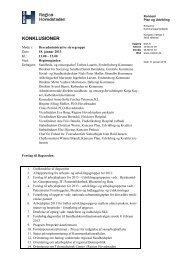Territorial Review Copenhagen - Region Hovedstaden
Territorial Review Copenhagen - Region Hovedstaden
Territorial Review Copenhagen - Region Hovedstaden
Create successful ePaper yourself
Turn your PDF publications into a flip-book with our unique Google optimized e-Paper software.
156<br />
but it does not have clear prioritisation of infrastructures and does not cover<br />
every mode of transport. Because a seamless intermodal transportation<br />
network affects the competitiveness of logistic sector, which many<br />
economic sectors depend on, the national government could benefit from a<br />
tool for co-ordination and prioritisation of every mode of transport, in<br />
accordance with business requirements. 13<br />
Institutional fragmentation of the metropolitan region poses a significant<br />
challenge, making an integral vision on transport modes and their<br />
connection difficult. Currently, no integrated transportation infrastructure<br />
system exists; several actors within the transportation field need to cooperate<br />
with each other. National and municipal governments are<br />
responsible for roads, based on the Danish Roads Act. The national<br />
government is largely responsible for the commuter train (S train) and<br />
regional trains. The national government, City of <strong>Copenhagen</strong> and the City<br />
of Frederiksberg own the metro based on separate legislation. However, a<br />
regional co-ordination mechanism is beginning to emerge. Since 2007, a<br />
single operator (Movia) has managed the public bus service in Sjaelland. It<br />
is owned by the two regions (the Capital <strong>Region</strong> and Sjaelland region) and<br />
the municipalities, who nominate the nine members of the board. This<br />
operator has full responsibility for total planning, including the pricing<br />
scheme, while each of 47 municipalities in the coverage area has<br />
responsibility for the operation and financing of bus service within the<br />
administrative boundary. Evidence suggests that this financing makes it<br />
difficult to agree on collective initiatives, such as marketing, because all<br />
costs have to be borne by the regions. Integrated transportation planning is<br />
increasingly necessary at the metropolitan level, as the development of each<br />
mode affects the others. Decision-making should be co-ordinated at strategic<br />
and operational level. Beyond the <strong>Copenhagen</strong> metropolitan area, crossborder<br />
co-ordination of transportation planning will also increasingly<br />
become necessary.<br />
Congestion charge in discussion<br />
Reflecting the regional scale of the congestion problem, congestion<br />
charges have been discussed extensively in the <strong>Copenhagen</strong> area over the<br />
last decade. Congestion charges have been introduced in several cities all<br />
over the world. Singapore has long and comprehensive experience and<br />
London, Oslo and Stockholm have followed suit. Like many cities in the<br />
OECD, <strong>Copenhagen</strong> is reflecting on the introduction of some form of<br />
congestion charges. Several surveys and analyses have been carried out that<br />
suggest a strong basis for decision-making on this matter. Different layouts<br />
of toll rings, multi-cordon systems and kilometre-based charging using GPS<br />
have been investigated and compared through field experiment (Rich and<br />
Nielsen, 2007).

















